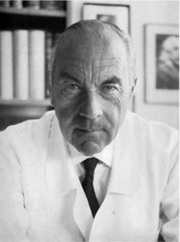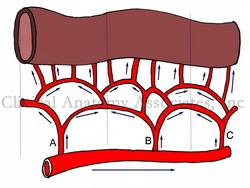
Medical Terminology Daily (MTD) is a blog sponsored by Clinical Anatomy Associates, Inc. as a service to the medical community. We post anatomical, medical or surgical terms, their meaning and usage, as well as biographical notes on anatomists, surgeons, and researchers through the ages. Be warned that some of the images used depict human anatomical specimens.
You are welcome to submit questions and suggestions using our "Contact Us" form. The information on this blog follows the terms on our "Privacy and Security Statement" and cannot be construed as medical guidance or instructions for treatment.
We have 368 guests online

Georg Eduard Von Rindfleisch
(1836 – 1908)
German pathologist and histologist of Bavarian nobility ancestry. Rindfleisch studied medicine in Würzburg, Berlin, and Heidelberg, earning his MD in 1859 with the thesis “De Vasorum Genesi” (on the generation of vessels) under the tutelage of Rudolf Virchow (1821 - 1902). He then continued as a assistant to Virchow in a newly founded institute in Berlin. He then moved to Breslau in 1861 as an assistant to Rudolf Heidenhain (1834–1897), becoming a professor of pathological anatomy. In 1865 he became full professor in Bonn and in 1874 in Würzburg, where a new pathological institute was built according to his design (completed in 1878), where he worked until his retirement in 1906.
He was the first to describe the inflammatory background of multiple sclerosis in 1863, when he noted that demyelinated lesions have in their center small vessels that are surrounded by a leukocyte inflammatory infiltrate.
After extensive investigations, he suspected an infectious origin of tuberculosis - even before Robert Koch's detection of the tuberculosis bacillus in 1892. Rindfleisch 's special achievement is the description of the morphologically conspicuous macrophages in typhoid inflammation. His distinction between myocardial infarction and myocarditis in 1890 is also of lasting importance.
Associated eponyms
"Rindfleisch's folds": Usually a single semilunar fold of the serous surface of the pericardium around the origin of the aorta. Also known as the plica semilunaris aortæ.
"Rindfleisch's cells": Historical (and obsolete) name for eosinophilic leukocytes.
Personal note: G. Rindfleisch’s book “Traité D' Histologie Pathologique” 2nd edition (1873) is now part of my library. This book was translated from German to French by Dr. Frédéric Gross (1844-1927) , Associate Professor of the Medicine Faculty in Nancy, France. The book is dedicated to Dr. Theodore Billroth (1829-1894), an important surgeon whose pioneering work on subtotal gastrectomies paved the way for today’s robotic bariatric surgery. Dr. Miranda.
Sources:
1. "Stedmans Medical Eponyms" Forbis, P.; Bartolucci, SL; 1998 Williams and Wilkins
2. "Rindfleisch, Georg Eduard von (bayerischer Adel?)" Deutsche Biographie
3. "The pathology of multiple sclerosis and its evolution" Lassmann H. (1999) Philos Trans R Soc Lond B Biol Sci. 354 (1390): 1635–40.
4. “Traité D' Histologie Pathologique” G.E.
Rindfleisch 2nd Ed (1873) Ballieres et Fils. Paris, Translated by F Gross
"Clinical Anatomy Associates, Inc., and the contributors of "Medical Terminology Daily" wish to thank all individuals who donate their bodies and tissues for the advancement of education and research”.
Click here for more information
- Details
The term "collateral circulation" is generally used to denote a situation where small blood channels dilate and provide blood supply when a pathology creates a stricture and diminishes blood flow (ischemia).
Although the above is correct, the term is also applicable to a normal, non-pathological situation most common in the human body. Please refer to the accompanying image for the following explanation. If needed, click on the image for a larger depiction. In the image, the arrows represent direction of flow.
Most organs or organ segments receive blood supply from more than one source of blood supply. In some cases, like the stomach, there are up to four arteries that provide blood supply to the organ: the right and left gastric arteries, and the right and left gastroepiploic arteries.
In other cases, like the small intestine shown in the image, blood arrives to the organ arising from several arteries (A, B, and C) that themselves arise from a parent structure. Because of hydrodynamics, the vascular territories of each artery (represented by dashed lines) tend not to overlap. If for any reason there is stenosis or blockage in any of these arteries (A,B, or C) blood will flow immediately through an alternate route and the organ will not suffer ischemia or necrosis.
This is extremely important, as these collateral channels maintain blood supply to areas that may be affected by bending, such as the elbow and knee, which have a rich collateral network. Most of the organs in the body, with some exceptions (brain, heart), have collateral circulation.
Collateral circulation is extremely important for surgery, as surgeons can safely remove parts of organs without affecting the blood supply to the organ. This is also true for all gastrointestinal anastomoses.
Image property of: CAA, Inc. Artist: Dr. Miranda
- Details
Histology is the scientific branch that studies tissues.
The root term [-hist-] is used to mean "tissues", but how the term came to be used is somewhat convoluted. It arises from the Greek [histos], which indicates the mast of a ship, it then was used to denote a Greek weaver's loom central mast (where the fabric is woven horizontally), and then it was used to indicate that which was woven [histios], the fabric, or the "tissues". The suffix [-ology] also has Greek origin from [logos] meaning a "book", a "treatise" or "to study".
The concept of the body being formed by different tissues was pioneered by Marie-Francois Xavier Bichat (1771-1802) who called them "membranes" Bichat is considered to be the "father of Histology". The image shows a histological slide of cardiac muscle. Click on the image for a larger depiction.
Original image by S. Girod and A. Becker, courtesy of Wikipedia.
- Details
The root term [-spondyl-] arises from the Greek [spondylos] meaning "vertebra", and suffix [-osis] means "condition", but with the connotation of "many". The word [spondylosis] means " condition of many vertebrae". This does not add much to the use of this word as an indicator of a pathology, but it does indicate that there is excess bone in a vertebral pathology.
Spondylosis is an osteoarthritic degeneration of the vertebrae and the spine characterized by abnormal bony growths on the vertebrae that can impinge on nerves and other structures causing pain and mobility problems. The definition of spondylosis also includes degenerative changes in the intervertebral discs.
The abnormal growth of portions of the vertebral body, usually forms "bone spurs", also referred to as "spondylophytes". The accompanying image shows a lumbar vertebra with spondylophytes.
Image property of: CAA, Inc. Photographer: David M. Klein
- Details
This article is part of the series "A Moment in History" where we honor those who have contributed to the growth of medical knowledge in the areas of anatomy, medicine, surgery, and medical research.

Dr. Rudolph Nissen
Dr. Rudolf Nissen (1896 - 1981). Dr Nissen’s life is extraordinary. Born in the city of Neisse, Germany in 1896, he was the son of a local surgeon. He studied medicine in the Universities of Munich, Marburg, and Breslau. He was the pupil of the famous pathologist Albert Aschoff (discoverer of the heart’s AV node, along with Sunao Tawara).
Nissen became a professor of surgery in Berlin, and in 1933 moved to Turkey where he was placed in charge of the Department of Surgery of the University of Istanbul. In 1939 he moved to the US, first to the Massachusetts General Hospital and later to the Jewish Hospital in Brooklyn, New York. After becoming a US citizen, he moved again in 1952 to Basel, Switzerland as Chief of the Department of Surgery, where he retired in 1967. He died in 1981.
His contributions to surgery are innumerable. He wrote over 30 books and 450 journal articles. Known for the development in 1956 of what is today known as the “Nissen fundoplication” for esophageal hiatus hernia surgery, Nissen also worked with his assistant, Dr. Mario Rossetti to develop the “floppy Nissen fundoplication”, also known as the “Nissen-Rossetti procedure”. This would be enough to honor this man, still, he (with Sauerbruch) performed the first lung lobectomy and the first pneumonectomy (called then a total pneumonectomy). In 1949 he performed the first esophagectomy with a gastroesophagostomy for lower esophageal cancer.
His personal life is even more interesting. Drafted at 20, he fought in WWI and was wounded several times. In 1933, under the Nazi regime, he was ordered to fire all the Jewish-German assistants under his care. Being Jewish himself, he was told that he would keep his job, Nissen could not take this. He resigned his position and moved out of Germany.
Another little known fact is that he operated on Albert Einstein in 1948. He operated on Einstein because of intestinal cysts. Having found a developing abdominal aortic aneurysm, he reinforced it with cellophane, undoubtedly giving his patient a few extra years to live. Einstein died in 1955.
As a personal side note, our good friend Dr. Aaron Ruhalter scrubbed in with Dr. Nissen while serving as a surgical resident at the Brooklyn Jewish Hospital!
Sources:
1. “Rudolf Nissen: The man behind the fundoplication” Schein et al. Surgery 1999;125:347-53
2. “Rudolf Nissen (1896–1981)-Perspective” Liebermann-Meffert, D. J Gastrointest Surg (2010) 14 (Suppl 1):S58–S61
3. “The Life of Rudolf Nissen: Advancing Surgery Through Science and Principle” Fults, DW; Taussky, P. World J Surg (2011) 35:1402–1408
4. “Total Pneumonectomy” Nissen, R. Ann Thorac Surg 1980; 29:390-394
5. “Historical Development of Pulmonary Surgery” Nissen, R. Am J Surg 80: Jan 1955 9- 15
Image in the public domain, courtesy of the Universitat Basel
- Details
The suffix [-oma] means "tumor", "mass", or "growth". It should be noted that the word [tumor] is originally Latin, and means "swelling" or "bulging". Sometimes the plural form [-omata] can be used.
It is a general misconception that the suffix [-oma] or the term [tumor] are synonymous with "cancer". This is not so. [Tumor] only means a mass and the type of mass, benign or malignant is not implied in the term. A cancerous mass will be denoted by the addition of the root term [-carcin-] meaning "cancer" therefore the combined root and suffix will be [-carcinoma]. There are other root-suffix combinations that also mean "cancerous".
The suffix [-oma] can be found in many medical words, such as:
- Hematoma: from the Greek root [-hem-] meaning "blood". A mass of blood
- Myoma: from the root [-my-] meaning "muscle". A mass, growth, or tumor of muscle
- Fibroma: from the root [-fibr-] meaning "fiber". A mass of fibers
- Fibromyoma: the combining form of "muscle" is [myo-], therefore "a mass of fibers and muscle" (Pl. fibromyomata)
- Adenoma: from the Greek [aden-] meaning "gland". A mass that has a glandular look to it or a mass in a gland
Sources:
1. "The Language of Medicine" John H. Dirckx Pub: Harper & Row 1976
2. "Medical Meanings" Haubrich, William S. Am Coll Phys Philadelphia 1997
3. "The origin of Medical Terms" Skinner, AH, 1970
- Details
This article is part of the series "A Moment in History" where we honor those who have contributed to the growth of medical knowledge in the areas of anatomy, medicine, surgery, and medical research.

Giovanni Batista Morgagni
Giovanni Battista Morgagni (1682 - 1771). Italian anatomist, physician, and pathologist, Morgagni was born in the city of Forli. He started his medical studies at the University of Bologna, graduating in 1701 with a degree in Medicine and Philosophy. In 1712 he became a professor of anatomy at the University of Padua, Italy, 175 years after Andreas Vesalius. Morgagni was offered and accepted the Chair of Anatomy in 1715 at the University of Padua. Although Morgagni held a position at the anatomy department of the University of Padua, his name is associated mostly with his pathological studies.
Morgagni was interested in the works of Theophile Boneti (1620 - 1689), who started analyzing the correlation between post-mortem anatomical findings and diseases. He tried to establish a relation between the disease and the cause of death. In 1761 Morgagni published his most influential work "De Sedibus et Causis Morburum Per Anatomen Indagatis" (On the Sites and Causes of Diseases, Investigated by Dissection). His work was essential for pathological anatomy to be recognized as a science in itself.
Morgagni was elected to become a member of several Academies of Science and Surgery: The Royal Society of London, The Academy of Science in Paris, The Berlin Academy of Science, and the Imperial Academy of Saint Petersburg in Russia. He is remembered today by several eponyms in anatomy and pathology:
- Morgagni's caruncle or lobe, referring to the middle lobe of the prostate
- Morgagni's columns: the anal (or anorectal) columns
- Morgagni's concha, referring to the superior nasal concha
- Morgagni's foramina: two hiatuses in the respiratory diaphragm allowing for passage of the superior epigastric vessels
- Morgagni's hernia: an hiatal hernia through Morgagni's foramen, in the respiratory diaphragm
- Morgagni's ventricle: an internal pouch or dilation between the true and false vocal cords in the larynx
- Morgagni's nodules: the nodules at the point of coaptation of the leaflets (cusps) of the pulmonary valve. Erroneously called the "nodules of Arantius", which are only found in the aortic valve
Sources:
1. "A Note From History: The First Printed Case Reports of Cancer" Hadju, S.I. Cancer 2010;116:2493–8
2. "Giovanni Battista Morgagni" Klotz, O. Can Med Assoc J 1932 27:3 298-303
3. "Morgagni (1682 -1771)" JAMA 1964 187:12 948-950
Original image in the public domain, courtesy of National Institutes of Health.




